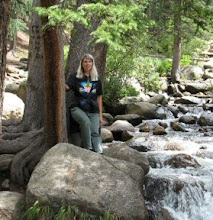
Curlleaf Mountain Mahogany (Cercocarpus ledifolius) is the rare exception. Four of these large evergreen shrubs grow near the Trading Post at Red Rocks Park, far from their normal range in the Intermountain West. These artificially introduced interlopers are not unwelcome, at least to me. One reason is that they don't seem to be invasive: four aging trees, no longer thriving, and one stump suggest long presence here, yet there is no sign of offspring. Research into that must await a more appropriate season. For now, we'll just enjoy the touch of life it adds to the winter landscape and its aesthetic charm against the red rocks of the Fountain Formation.

Despite the cyanogenic glucoside Curlleaf Mountain Mahogany apparently contains,a it's enormously popular as a browse for wild ungulates. So is our local species, variously "true," "alderleaf," or just plain Mountain Mahogany (Cercocarpus montanus), which would look like this in a different season, but today looks more like a "Cerco-carcass."
 (Photo of Alderleaf Mountain-mahogany leaves and seeds -- July 2005, Nikon D70, by Cory Maylett, via Wikipedia.)
(Photo of Alderleaf Mountain-mahogany leaves and seeds -- July 2005, Nikon D70, by Cory Maylett, via Wikipedia.)My first Rocky Mountain ecology teacher used to call this plant "deer ice cream," and our shrubs are generally "managed" within browsing height by the frequent deer pruning they receive. They rarely reach much more than a meter in height.
Curlleaf, in contrast, grows more as a tree and exceeds the reach of its would-be predators, whose munching efforts among its lower branches apparently help stimulate its upward growth.b In deer feeding studies back in the 1940s and 50s, curlleaf was deemed "most desirable" of 17 species of browse offered to captive deer. A hybrid between these two species was ranked second, though data were limited.c
The overlapping ranges shown above create the opportunity for hybridization, with the two occurring together at lower elevations in Utah and other intermountain areas. That factor also contributes to complex intraspecific taxonomic issues, so we're fortunate that here in eastern Colorado, the situation seems to be a little more straightforward.
Lots more to learn about Curlleaf Mountain Mahogany at this site.

Coincidentally, last week before the snows I encountered another individual of the curlleaf species about four miles (7 km) south of the Trading Post. I was surprised to spot it, but again, it was in an area of our foothills long popular with original Americans as well as with later inhabitants. This tree, however, had an unusually intimate relationship with a large boulder next to it. It had grown into and around this huge chunk of red sandstone, or, it appeared, the rock had grown into it.

I have to confess I'm rather baffled by this one. The boulder is on the downhill side of the tree, and what you see in these photos are the trunk and branches, not roots, of a mature tree. I'm looking forward to suggestions from readers on how this might have happened.
———
aDhurrin, the cyanogenic glucoside of Cercocarpus ledifolius (pdf), Nahrstedt and Limmer, 1982, Phytochemistry Volume 21, Issue 11, Pages 2738–2740
bResponse of Curlleaf Mountain Mahogany to Pruning Treatments in Northern Utah (pdf), Austin and Urness, July 1980, J Range Mngt 33(4), 275-277
cFeeding deer on browse species during winter, Smith, Arthur D., 1950, J. Range Mngt 3(2):130-132






